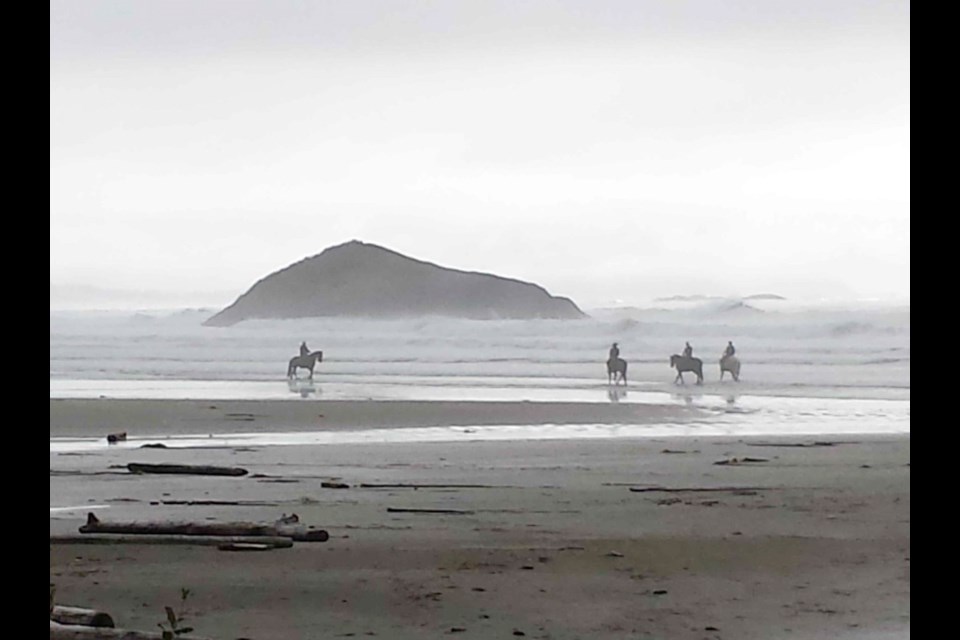Filming of sequences for a Hollywood movie scheduled for release in summer of 2017 has yielded an estimated economic impact of $1.5 million for coastal communities near Pacific Rim National Park Reserve.
The film’s working title, Hidden Fortress, seems appropriate, since it reflects the secrecy surrounding last month’s filming for the next Planet of the Apes movie in Ucluelet and on public beaches.
“It wasn’t a very well-kept secret out here,” said Dave Christensen, president of the Ucluelet Chamber of Commerce, referring to widespread knowledge the film was actually War for the Planet of the Apes.
Pre-production began in August after extensive location scouting for a few days of filming of scenes for director Matt Reeves’ picture that recently wrapped.
“There was a huge list of epic locations,” said Joan Miller, film commissioner with Vancouver Island North Film Commission.
“There wasn’t a back road or waterfall we missed, and it came down to this beautiful vista they could really work with on the west coast.”
The economic benefits to the population and businesses in Ucluelet, where construction and most of the filming took place, and neighbouring Tofino were substantial, she said.
The five major locations used included First Nations land, Pacific Rim National Park oceanfront and private property. Key sequences were filmed on the oceanfront site where developer Elke Loof-Koehler had envisioned the 370-acre Wyndansea Oceanfront Resort. The resort project that went into receivership in 2009 would have had a Jack Nicklaus-designed golf course, two hotels and hundreds of homes.
“This was a Ucluelet-based production,” Miller said. “Ucluelet really gets it. Maybe it’s because they’re always seen as the second sister, but they really try hard.”
While production details were kept under wraps, large sets were built on private land, and the crew numbered 200, including 20 locations staffers, 35 local carpenters and 15 security guards.
“Protecting the integrity of the story was obviously very important,” said Miller, explaining why the filmmakers needed private locations without public access in addition to shoots in the park reserve.
She credited Parks Canada officials for being “great to work with” and “having a complete understanding of how important it is to balance access to a public environment, and opportunity,” for helping make it happen.
“Those are the iconic beaches that we shot Twilight on. This is going to be a huge benefit to the national parks. People are going to want to come and see these beautiful beaches.”
Christensen said it was significant that so much labour and materials were locally sourced, with area hotels, resorts, retailers and restaurants among businesses most favourably affected.
“The spinoff goes right through a community of this size, because we’re only 1,700 people here,” he said. “The community is very tourism-based, so to get any other industry helps diversify the economy.”
The local Windsor Plywood store, for instance, benefited through large purchases of lumber, plywood and other building materials, said general manager Robin Cooley.
“And we got a bunch of it back when they were done,” she said.
“It’s surprising all the time and money that goes into it, and then they only film for three or four days.”
While there’s plenty of monkey business in the new film starring Woody Harrelson, Steve Zahn, Andy Serkis and Sara Canning, locals and tourists also couldn’t help notice there’s some horsing around.
Although horses are permitted to be on local beaches, one of the challenges was that “there’s not a base of horses on the west coast,” so animals had to be brought in, said Miller.
Big equipment such as cranes, excavators and backhoes were acquired locally, and imported from Port Alberni.
Ucluelet has gained a reputation as a particularly film-friendly community after accommodating filmmakers shooting sequences for projects such as Man of Steel and Twilight: New Moon.
Other movies have also been shot on the Island with working titles.
Man of Steel was originally titled Autumn Frost; Twilight: New Moon was called Untitled Sports Movie; Disney’s Descendants was known as Off the Island; and Godzilla was code-named Nautilus.
The Hidden Fortress shoot marks the longest stay by filmmakers in Ucluelet “from start to finish,” Ucluelet Mayor Dianne St. Jacques said.
“It’s wonderful, especially in the shoulder season,” she said. “We love it. It’s very exciting and the crews have been great. We’re happy to have a little bit of Hollywood coming to town.”
Local hotels including Black Rock Resort and Water’s Edge Shoreside Suites, where St. Jacques is general manager, filled up with cast and crews who shopped and dined out locally, she said.
“It was definitely nice to see them using so many locals and we were good hosts,” she said. “I believe they enjoyed their time here.”



